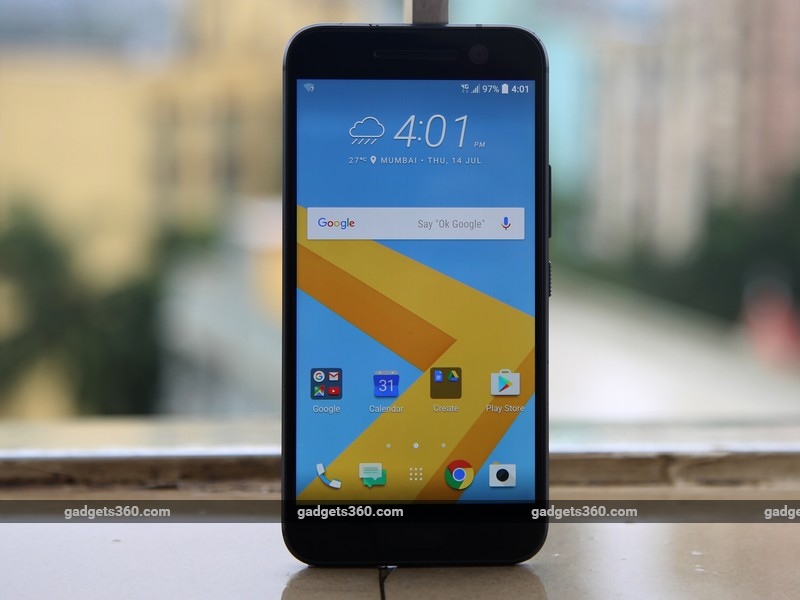
HTC has gone from being an OEM for the likes of Dell and HP to producing some of the finest and most iconic Android smartphones of the last five years under its own banner. It’s also recently diversified its business into the virtual reality space with HTC Vive Tech Corporation.
However, the profitability of the company’s smartphone business has been a sore subject for some time, and recent reports suggest things are still not quite right. Despite this, HTC continues to churn out smartphones and just a couple of months ago, it launched not one, but seven new models in India.
Our focus for today is the company’s flagship for 2016, called the HTC 10. Unlike LG and Samsung which had an early start with their flagships, HTC thought it best to be fashionably late to the party. Will this strategy pay off? Our initial impressions of the phone were pretty positive, and it’s now time to put it to the test.
Design and build
The one thing HTC has gotten right since the original One is aesthetics, and we’re happy to see that the 10 is no different. Sculpted from a single block of aluminium, the phone feels as premium as they come. The body is built ergonomically but the smooth finish doesn’t offer much grip, which can be a problem when using the phone with one hand. The phone has a distinctively wide chamfered edge on the back which looks nice when light catches it. We did notice that the edges around the display can feel a little sharp when you hold this phone.
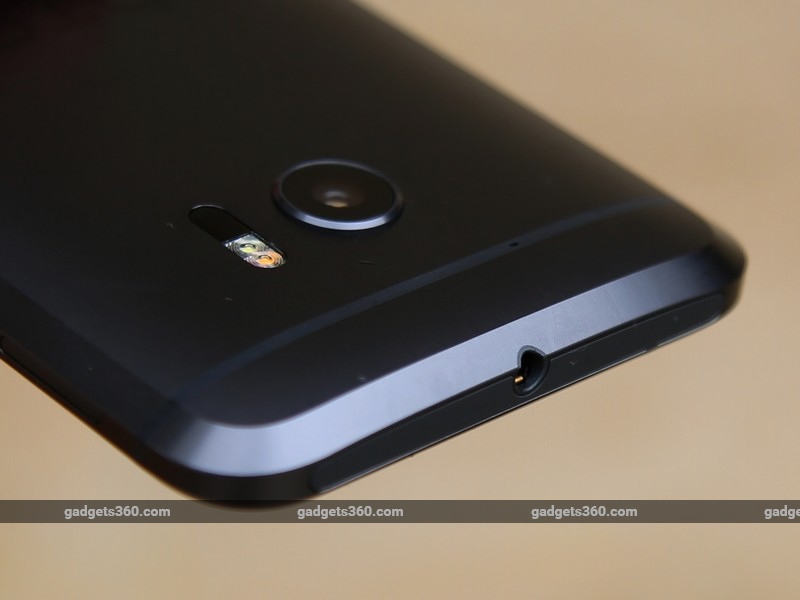 The display is a sensibly sized 5.2-inch Super LCD 5 panel with a Quad HD (1440×2560) resolution and Gorilla Glass protection. What we really love is the way the display curves around the edges, the earpiece and the capacitive Home button, looking like a layer of liquid on top of stone. Display quality is great, with good colour reproduction and accurate touch response. You can choose between ‘Vivid’ or ‘sRGB’ colour profiles and also fine tune the colour temperature for each. There are backlit navigation keys on either side of the Home button, which also houses the fingerprint sensor.
The display is a sensibly sized 5.2-inch Super LCD 5 panel with a Quad HD (1440×2560) resolution and Gorilla Glass protection. What we really love is the way the display curves around the edges, the earpiece and the capacitive Home button, looking like a layer of liquid on top of stone. Display quality is great, with good colour reproduction and accurate touch response. You can choose between ‘Vivid’ or ‘sRGB’ colour profiles and also fine tune the colour temperature for each. There are backlit navigation keys on either side of the Home button, which also houses the fingerprint sensor.
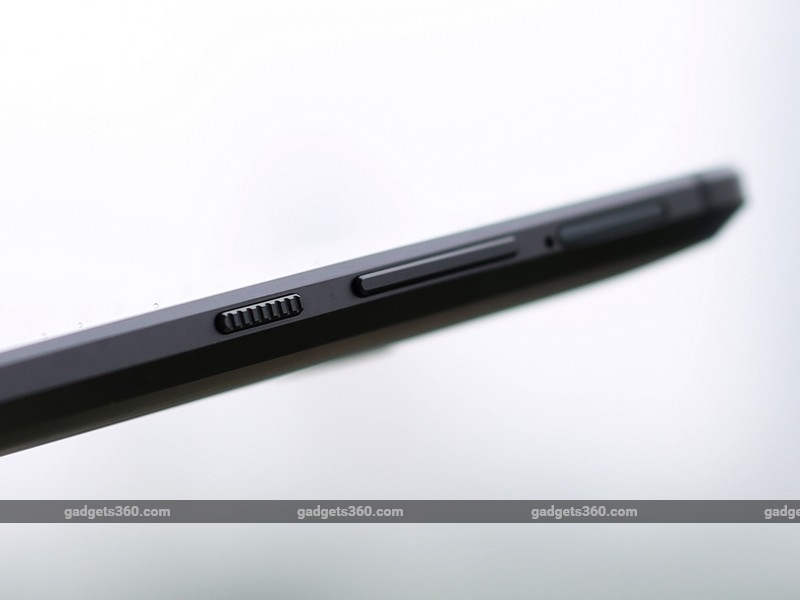 The HTC 10 has separate trays on either side for a microSD card (up to 2TB) and a SIM. The volume and power buttons are well crafted with good tactile feedback, and the latter gets additional ridges to help you locate it by touch. The 3.5mm headphone socket is on the top while the USB Type-C port and speaker are on the bottom. The Type-C port on the 10 supports USB 3.1 Gen 1 speeds so you can take advantage of faster data transfers. Remember to enable this feature in the Settings app.
The HTC 10 has separate trays on either side for a microSD card (up to 2TB) and a SIM. The volume and power buttons are well crafted with good tactile feedback, and the latter gets additional ridges to help you locate it by touch. The 3.5mm headphone socket is on the top while the USB Type-C port and speaker are on the bottom. The Type-C port on the 10 supports USB 3.1 Gen 1 speeds so you can take advantage of faster data transfers. Remember to enable this feature in the Settings app.
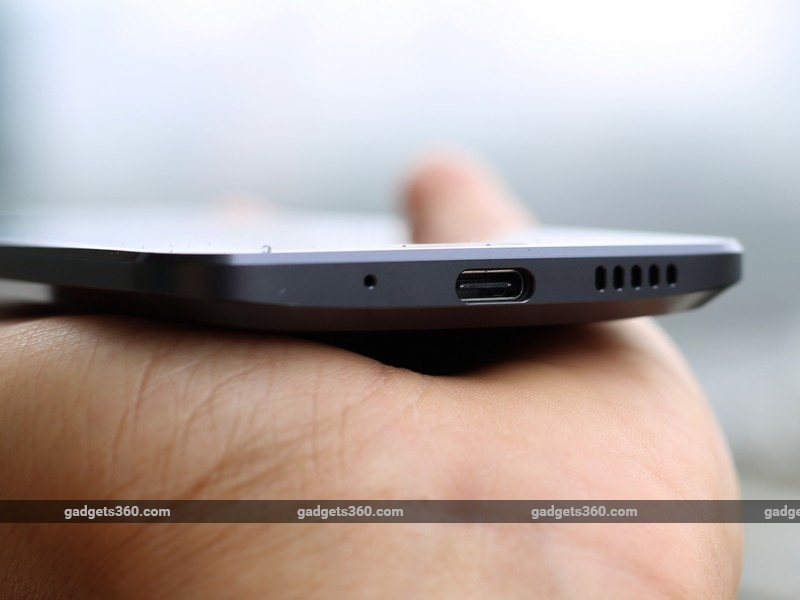 The slightly curved back houses the 12 UltraPixel 2 camera, laser autofocus sensor, and dual-tone LED flash. The camera lens bulges slightly from the back but there’s a metal ring protecting it, and during our review period, we didn’t find any scuffs or chipped paint.
The slightly curved back houses the 12 UltraPixel 2 camera, laser autofocus sensor, and dual-tone LED flash. The camera lens bulges slightly from the back but there’s a metal ring protecting it, and during our review period, we didn’t find any scuffs or chipped paint.
We were sent just the phone for review with no accessories. In the retail box, you can expect to find a data cable, a Quick Charge 3.0 compatible adapter, and a headset.
Specifications and features
In terms of power, the HTC 10 packs in nothing but the best. We have Qualcomm’s Snapdragon 820 quad-core SoC, 4GB of RAM, and 32GB or flash storage. This results in some pretty good benchmarks numbers. We got 118,856 in AnTuTu and a healthy 53fps in GFXbench. Other specifications include Category 9 LTE speeds for most Indian 4G bands, Bluetooth 4.2, NFC, dual-band Wi-Fi b/g/n/ac, USB OTG, and GPS. There is no FM radio. The phone also seems to have reverse charging which makes it act like a power bank. The option pops up when you plug in a USB device.
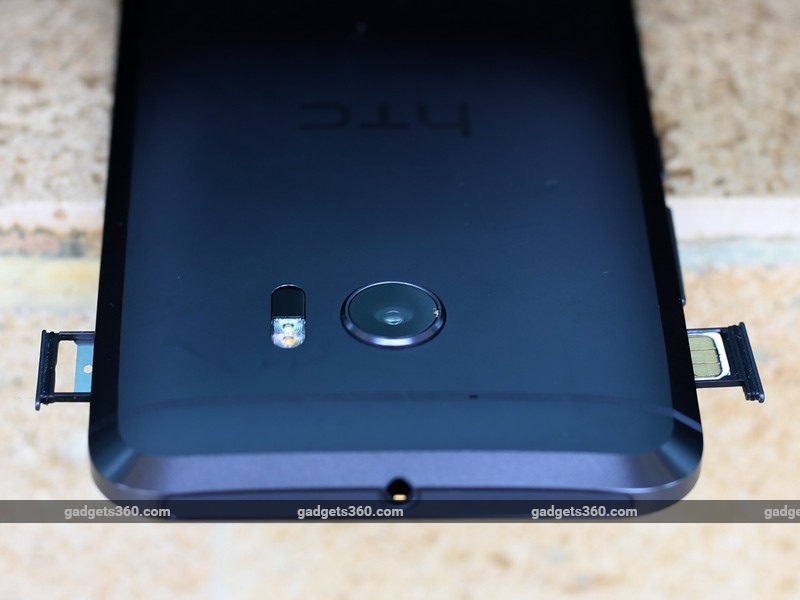 HTC’s Sense user interface over Android Marshmallow is now incredibly minimalist and that’s a very good thing. In fact, the company has ditched many of its own apps (Gallery, Music) in favour of Google’s native ones, which makes for a lean, clutter-free inerface. Blinkfeed is still present when you swipe right from the homescreen, but it can be turned off if you never use it. It gives you news snippets from Twitter and the News Republic app, but you can also sync your calendar, Google+, LinkedIn and meal recommendations from restaurants around you.
HTC’s Sense user interface over Android Marshmallow is now incredibly minimalist and that’s a very good thing. In fact, the company has ditched many of its own apps (Gallery, Music) in favour of Google’s native ones, which makes for a lean, clutter-free inerface. Blinkfeed is still present when you swipe right from the homescreen, but it can be turned off if you never use it. It gives you news snippets from Twitter and the News Republic app, but you can also sync your calendar, Google+, LinkedIn and meal recommendations from restaurants around you.
A long press on the homescreen lets you change the screen layout from ‘Classic’ to something called ‘Freestyle’. What this does is change the entire theme of the phone (based on what you select) and replace most of the icons with stickers. You can link the stickers to apps or simply use them for decoration. It’s a fun concept but the novelty may wear off after a few days.
 The Themes app lets you change the look of your phone in one go or you can individually choose an icon set, wallpaper, sounds, and fonts. The Boost+ app automatically cleans junk files to free up storage at set intervals. In addition to this, you can lock apps with your fingerprint, uninstall apps, and optimise games in order to get more battery life. You also get the usual Google apps and Zoe Video Editor which helps you create short films from your photo collection.
The Themes app lets you change the look of your phone in one go or you can individually choose an icon set, wallpaper, sounds, and fonts. The Boost+ app automatically cleans junk files to free up storage at set intervals. In addition to this, you can lock apps with your fingerprint, uninstall apps, and optimise games in order to get more battery life. You also get the usual Google apps and Zoe Video Editor which helps you create short films from your photo collection.
The Settings app contains tools to import your data from an older Android phone or iPhone; HTC Connect for streaming media to compatible devices; Motion launch gestures for accessing features when the display is off; HTC Mini+ support; and HTC BoomSound.
Performance
The HTC 10 never skipped a beat during our rigorous test period. There were a few moments when the interface would stutter, but these were few and far between. Call quality is rather excellent, with clear audio from the earpiece. We found that the phone doesn’t overheat during regular use but it does get noticeably hot when using the camera.
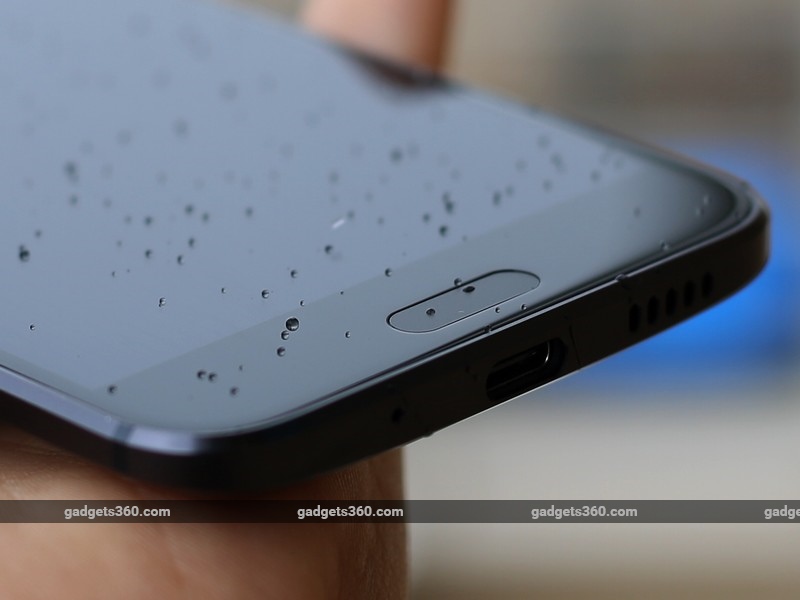 Google’s Photos app has been tweaked to accommodate slow-motion videos and RAW files which the camera is capable of capturing. Audio is handled by the Play Music app and it’s business as usual here. BoomSound is present and is backed by Dolby Audio. You get a dual-speaker setup, each powered by its own amplifier, but this time, the bottom speaker fires downwards instead of towards you. It still sounds great but isn’t as immersive as two stereo speakers. The phone has also been designed with a high-resolution DAC which supports 24-bit audio. This lets you take full advantage of a good pair of headphones and your FLAC files.
Google’s Photos app has been tweaked to accommodate slow-motion videos and RAW files which the camera is capable of capturing. Audio is handled by the Play Music app and it’s business as usual here. BoomSound is present and is backed by Dolby Audio. You get a dual-speaker setup, each powered by its own amplifier, but this time, the bottom speaker fires downwards instead of towards you. It still sounds great but isn’t as immersive as two stereo speakers. The phone has also been designed with a high-resolution DAC which supports 24-bit audio. This lets you take full advantage of a good pair of headphones and your FLAC files.
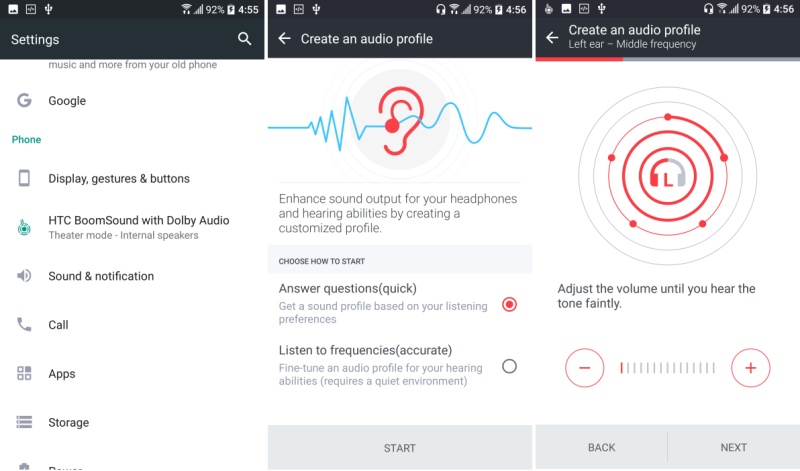 BoomSound lets you toggle between Theatre and Music modes when using the loudspeaker, but plug in a pair of headphones and the options change. You can now toggle BoomSound on or off and enable Dolby headphone effects. With it enabled, audio sounds richer and louder with tighter bass. Finally, we have Personal audio profile wizard that takes you through a series of steps in order to fine-tune frequencies based on your personal tastes, similar to Samsung’s Adapt Sound feature.
BoomSound lets you toggle between Theatre and Music modes when using the loudspeaker, but plug in a pair of headphones and the options change. You can now toggle BoomSound on or off and enable Dolby headphone effects. With it enabled, audio sounds richer and louder with tighter bass. Finally, we have Personal audio profile wizard that takes you through a series of steps in order to fine-tune frequencies based on your personal tastes, similar to Samsung’s Adapt Sound feature.
Cameras have been a bit of sore subject for HTC’s flagship devices but we can happily say that trend has been broken with the 10. It’s still not the best nor is it perfect in any way, but there’s been good progress. HTC is sticking to its Ultrapixel technology and now with version 2.0, we have a 12-megapixel resolution with a large pixel size of 1.55um. There’s also a fairly large f/1.8 aperture, OIS, and laser autofocus. All of this comes together pretty well in delivering highly detailed and noise-free pictures. The sensor does a very good job with capturing accurate colours too.



 (Tap to see full size HTC 10 camera samples)
(Tap to see full size HTC 10 camera samples)
In daylight, distant objects in landscape shots are fairly well defined although slight chromatic aberration is present. Macros tend to lack punch when you crop them but look good when viewed normally. The large aperture also gives you an excellent bokeh effect, which is handy when shooting portraits. Low-light performance is also good with little to no chroma noise ruining details in dark areas.
The camera app is lean and quick, giving you basic controls on the right and the menu for switching shooting modes on the left. The flash and Auto HDR toggles are prominently displayed for ease of use. Other than the standard shooting mode, you get Zoe camera, which captures a still and few seconds of video. There’s also Panorama and Pro modes. The latter lets you manually adjust focus, shutter speed (2 to 1/8000 sec), ISO (100-3200), white balance and exposure. This mode also lets you save images as in 12-bit RAW (DNG) files.
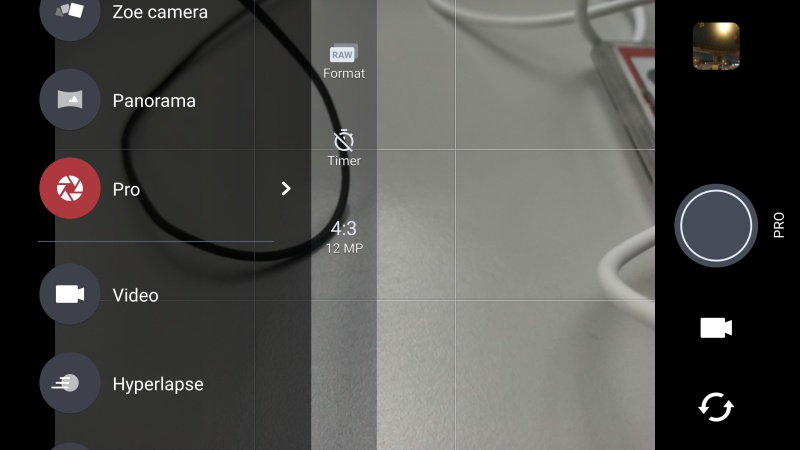 The app, while slick and fast, could use a bit of tweaking. For instance, a warning would intermittently flash on the screen alerting us to unblock the laser autofocus sensor even when there was nothing blocking it. We sometimes had to tap the focus ring multiple times for a macro shot to make sure the subject was in focus. We also found some irregularities with the camera’s light metering system. At times, in low-light, the HTC 10 would simply refuse to meter a scene properly, despite us tapping to lock focus.
The app, while slick and fast, could use a bit of tweaking. For instance, a warning would intermittently flash on the screen alerting us to unblock the laser autofocus sensor even when there was nothing blocking it. We sometimes had to tap the focus ring multiple times for a macro shot to make sure the subject was in focus. We also found some irregularities with the camera’s light metering system. At times, in low-light, the HTC 10 would simply refuse to meter a scene properly, despite us tapping to lock focus.
On a more positive note, video recording is handled well at resolutions up to 4K. You can even toggle high-res 24-bit audio recording. You can capture hyperlapse and slow-motion videos, both of which look great.
This is the first phone to feature OIS for the front camera. It does help stabilise shots to an extent, which is helpful in low light. The 5-megapixel autofocus front camera might not seem like much but coupled with larger pixels (1.34um) and a large f/1.8 aperture, you’re looking at some well-defined selfies.
Battery life
The 3000mAh battery lasted for 8 hours and 23 minutes in our video loop test, which was a bit disappointing. However, with real-world usage, we managed to easily go past a full day before needing to charge this phone. The HTC 10 supports Qualcomm’s Quick Charge 3.0 which promises a 50 percent charge in just 30 minutes.
 Verdict
Verdict
The HTC 10 gets a proper flagship price of Rs. 52,990 which puts it right up there with the Samsung Galaxy S7 (Review) and the LG G5 (Review). With such a high price, it’s not unreasonable to expect perfection and the HTC 10 does deliver that on some counts, but not all. That then begs the question, does it make sense spending this kind of money for such a device when you could get a similar experience at nearly half the price? The OnePlus 3 (Review) has proven to be a worthy low-cost flagship this year, offering premium level performance at a price most can afford. We sincerely hope the South Korean and Taiwanese brigade re-think their next flagship offerings.
Coming back to the device at hand, the HTC 10 is a beautiful, well crafted smartphone with the most powerful components available today. For a change, we can happily say that camera performance is also very good, though a notch behind the Galaxy S7 and LG G5. We also love HTC’s new lean approach when it comes to software. Loyal HTC fans will pick this phone up in a heartbeat, but for everyone else, it’s tough to recommend. The Samsung Galaxy S7 dominates the Android flagship space,and many other phones which cost less are good enough as well.
